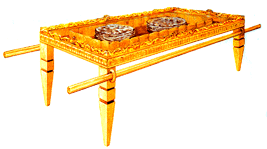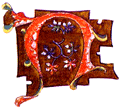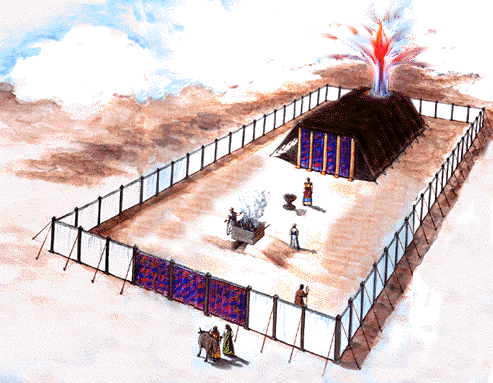The Table of Shewbread (Ex 25:23-30)

It was also called the Table of the Presence.
 Now
we will pass through
the door of
the tabernacle and enter the holy place. The priest had at his right hand
the table of shewbread or also referred to as the table of the presence. It
was made of
acacia wood overlaid with pure
gold. Its size was 2 cubits (3 feet) in length by one
cubit (1 1/2 feet) in breadth and a height of 1 1/2 cubits (2 1/4 feet).
Around the table was a border of gold and then a little further in, on the table
top, an additional border which would hold the contents in place. The table had
four legs, and two gold plated
poles were inserted through golden rings attached to the legs for
transporting.
Now
we will pass through
the door of
the tabernacle and enter the holy place. The priest had at his right hand
the table of shewbread or also referred to as the table of the presence. It
was made of
acacia wood overlaid with pure
gold. Its size was 2 cubits (3 feet) in length by one
cubit (1 1/2 feet) in breadth and a height of 1 1/2 cubits (2 1/4 feet).
Around the table was a border of gold and then a little further in, on the table
top, an additional border which would hold the contents in place. The table had
four legs, and two gold plated
poles were inserted through golden rings attached to the legs for
transporting.
Exod 25:23-30 "You shall also make a table of acacia wood; two cubits shall be its length, a cubit its width, and a cubit and a half its height. And you shall overlay it with pure gold, and make a molding of gold all around. You shall make for it a frame of a handbreadth all around, and you shall make a gold molding for the frame all around. And you shall make for it four rings of gold, and put the rings on the four corners that are at its four legs. The rings shall be close to the frame, as holders for the poles to bear the table. And you shall make the poles of acacia wood, and overlay them with gold, that the table may be carried with them. You shall make its dishes, its pans, its pitchers, and its bowls for pouring. You shall make them of pure gold. And you shall set the showbread on the table before Me always."
The purpose of the golden table was to hold 12 cakes of bread made of fine flour. They were placed there in two rows of six, each loaf representing one of the tribes of Israel (Lev. 24:8).
Lev 24:5-9 "And you shall take fine flour and bake twelve cakes with it. Two-tenths of an ephah shall be in each cake. You shall set them in two rows, six in a row, on the pure gold table before the LORD. And you shall put pure frankincense on each row, that it may be on the bread for a memorial, an offering made by fire to the LORD. Every Sabbath he shall set it in order before the LORD continually, being taken from the children of Israel by an everlasting covenant. And it shall be for Aaron and his sons, and they shall eat it in a holy place; for it is most holy to him from the offerings of the LORD made by fire, by a perpetual statute."
The historian Josephus indicates that the bread was unleavened. This bread is sometimes referred to as being the 'shewbread' because its literal meaning is 'bread of the face', i.e. bread set out before the face or presence of God.
![]()
This is the first mention of the word "table" (communion & fellowship) in the Bible. (comment)
![]()
The Table
-It was made of acacia wood overlaid with gold.
-It was 2 cubits long, 1 cubit wide and 1 1/2 cubits high. (the ark was the same height).
-It had a gold molding (crown) all around.
-The molding was the width of a hand (to secure the bread)
-It had a gold ring at each corner leg for the staves (wood overlaid with gold).
The Four vessels
-There were 4 vessels of pure gold on the table with the bread:
Dishes (breadplates)
Pans or Spoons (to sprinkle frankincense)
Pitchers (for liquid offerings)
Bowls (vessels containing the frankincense)

Each of the 12 cakes represented one of the tribes of Israel.
-The tables purpose was to show the bread, which were 12 small, flat, round loaves that were laid out in an orderly fashion so as to be displayed.
Lev 24:5-6 "And you shall take fine flour and bake twelve cakes with it. Two-tenths of an ephah shall be in each cake. "You shall set them in two rows, six in a row, on the pure gold table before the LORD.
- Fine Flour (from the earth)
- Baked (agony and suffering)
- Unleavened (nothing artificial)
- Two-tenths (two deals of ten)
- Sprinkled with pure frankincense
Lev 24:8-9 "Every Sabbath he shall set it in order before the LORD continually, being taken from the children of Israel by an everlasting covenant. And it shall be for Aaron and his sons, and they shall eat it in a holy place; for it is most holy to him from the offerings of the LORD made by fire, by a perpetual statute."
-Every seventh (Sabbath) day, fresh hot loaves were provided by Aaron. The priests were entitled to eat the old loaves while standing in the Holy Place.
-The frankincense that was removed each week was as a special oblation (offering) to God.
-12 loaves were the same material, size, and weight (no partiality).
-According to Lev 22, if a priest was unclean he couldn't eat of the shewbread. No layman, or daughter married to a layman, or a hired servant could eat of the shewbread. But a purchased slave or those born in his house could.
-According to tradition 8 priests held hands as they changed the bread, and passed it for fellowship.
-They were to be holy because of the bread
Lev 21:6 `They shall be holy to their God and not profane the name of their God, for they offer the offerings of the LORD made by fire, and the bread of their God; therefore they shall be holy.
No Sitting Down
For although the bread was on a table, no priest could ever be seated at that table or anywhere else in the tabernacle. Priests always stood while they carried out their duties. There was no place to be seated, no provision for rest in this pattern of worship and no suggestion that their task was ever completed.
Heb 10:11-14 "And every priest stands ministering daily and offering repeatedly the same sacrifices, which can never take away sins. But this Man, after He had offered one sacrifice for sins forever, sat down at the right hand of God, from that time waiting till His enemies are made His footstool. For by one offering He has perfected forever those who are being sanctified."
Journeying
Num 4:5-8 "When the camp prepares to journey, Aaron and his sons shall come, and they shall take down the covering veil and cover the ark of the Testimony with it. Then they shall put on it a covering of badger skins, and spread over that a cloth entirely of blue; and they shall insert its poles. On the table of the Presence they shall spread a blue cloth, and put on it the dishes, the pans, the bowls, and the pitchers for pouring; and the showbread shall be on it. They shall spread over them a scarlet cloth, and cover the same with a covering of badger skins; and they shall insert its poles."
 A Type of Christ
A Type of Christ
The table of shewbread was referred to as the table of the Presence. Gods light forever shines on His people. The 12 baked cakes of bread spoke of Gods people who were one with Him as the priests joined together for the fellowship of eating the bread and becoming one. Jesus referred to Himself as the bread of life and said if we eat this bread we will live forever. The very nature of bread is to provide physical sustenance and as you eat the bread and digest it, it becomes part of you. The very nature of the Word of God is to provide spiritual sustenance and as it is received it becomes part of our very nature. Just as the table always speaks of fellowship and communion, so the table of the shewbread points to Jesus who has made a covenant built on better promises and provided a blood covenant meal for us to partake that we might all be one in the Spirit.
John 6:35 And Jesus said to them, "I am the bread of life. He who comes to Me shall never hunger, and he who believes in Me shall never thirst."
Jn 6:51-58 "I am the living bread which came down from heaven. If anyone eats of this bread, he will live forever; and the bread that I shall give is My flesh, which I shall give for the life of the world. As the living Father sent Me, and I live because of the Father, so he who feeds on Me will live because of Me. This is the bread which came down from heaven-- not as your fathers ate the manna, and are dead. He who eats this bread will live forever."
Jn 6:63 "It is the Spirit who gives life; the flesh profits nothing. The words that I speak to you are spirit, and they are life."
Only in the work of Christ as great high priest on behalf of his people was the work ever finished. His sacrifice was fully effective and was a completed work. No priest could ever be seated but after his great cry, 'It is finished', Jesus Christ left the altar of Calvary and sat down at the right hand of God.
 Jesus said, "I am the bread of life."
Jesus said, "I am the bread of life."
Read The Bible
- 1599 Geneva Bible (GNV)
- 21st Century King James Version (KJ21)
- American Standard Version (ASV)
- Amplified Bible (AMP)
- Amplified Bible, Classic Edition (AMPC)
- Authorized (King James) Version (AKJV)
- BRG Bible (BRG)
- Christian Standard Bible (CSB)
- Common English Bible (CEB)
- Complete Jewish Bible (CJB)
- Contemporary English Version (CEV)
- Darby Translation (DARBY)
- Disciples’ Literal New Testament (DLNT)
- Douay-Rheims 1899 American Edition (DRA)
- Easy-to-Read Version (ERV)
- English Standard Version (ESV)
- English Standard Version Anglicised (ESVUK)
- Evangelical Heritage Version (EHV)
- Expanded Bible (EXB)
- GOD’S WORD Translation (GW)
- Good News Translation (GNT)
- Holman Christian Standard Bible (HCSB)
- International Children’s Bible (ICB)
- International Standard Version (ISV)
- J.B. Phillips New Testament (PHILLIPS)
- Jubilee Bible 2000 (JUB)
- King James Version (KJV)
- Lexham English Bible (LEB)
- Living Bible (TLB)
- Modern English Version (MEV)
- Mounce Reverse Interlinear New Testament (MOUNCE)
- Names of God Bible (NOG)
- New American Bible (Revised Edition) (NABRE)
- New American Standard Bible (NASB)
- New American Standard Bible 1995 (NASB1995)
- New Catholic Bible (NCB)
- New Century Version (NCV)
- New English Translation (NET)
- New International Reader's Version (NIRV)
- New International Version - UK (NIVUK)
- New International Version (NIV)
- New King James Version (NKJV)
- New Life Version (NLV)
- New Living Translation (NLT)
- New Matthew Bible (NMB)
- New Revised Standard Version (NRSV)
- New Revised Standard Version Catholic Edition (NRSVCE)
- New Revised Standard Version, Anglicised (NRSVA)
- New Revised Standard Version, Anglicised Catholic Edition (NRSVACE)
- New Testament for Everyone (NTE)
- Orthodox Jewish Bible (OJB)
- Revised Geneva Translation (RGT)
- Revised Standard Version (RSV)
- Revised Standard Version Catholic Edition (RSVCE)
- The Message (MSG)
- The Voice (VOICE)
- Tree of Life Version (TLV)
- World English Bible (WEB)
- Worldwide English (New Testament) (WE)
- Wycliffe Bible (WYC)
- Young's Literal Translation (YLT)
Table of Contents
Main Menu
- Ancient Assyrian Social Structure
- Ancient Babylonia
- Ancient Canaan During the Time of Joshua
- Ancient History Timeline
- Ancient Oil Lamps
- Antonia Fortress
- Archaeology of Ancient Assyria
- Assyria and Bible Prophecy
- Augustus Caesar
- Background Bible Study
- Bible
- Biblical Geography
- Fallen Empires - Archaeological Discoveries and the Bible
- First Century Jerusalem
- Glossary of Latin Words
- Herod Agrippa I
- Herod Antipas
- Herod the Great
- Herod's Temple
- High Priest's in New Testament Times
- Jewish Literature in New Testament Times
- Library collection
- Map of David's Kingdom
- Map of the Divided Kingdom - Israel and Judah
- Map of the Ministry of Jesus
- Matthew Henry Bible Commentary
- Messianic Prophecy
- Nero Caesar Emperor
- Online Bible Maps
- Paul's First Missionary Journey
- Paul's Second Missionary Journey
- Paul's Third Missionary Journey
- Pontius Pilate
- Questions About the Ancient World
- Tabernacle of Ancient Israel
- Tax Collectors in New Testament Times
- The Babylonian Captivity
- The Black Obelisk of Shalmaneser
- The Books of the New Testament
- The Court of the Gentiles
- The Court of the Women in the Temple
- The Destruction of Israel
- The Fall of Judah with Map
- The History Of Rome
- The Incredible Bible
- The Jewish Calendar in Ancient Hebrew History
- The Life of Jesus in Chronological Order
- The Life of Jesus in Harmony
- The Names of God
- The New Testament
- The Old Testament
- The Passion of the Christ
- The Pharisees
- The Sacred Year of Israel in New Testament Times
- The Samaritans
- The Scribes
Ancient Questions
- Why Do the Huldah Gates Appear Different in Ancient Replicas and Modern Photos?
- What Is the Origin of the Japanese and Chinese Peoples? A Biblical Perspective
- How did the ancient Greeks and Romans practice medicine and treat illnesses?
- What were the major contributions of ancient Babylon to mathematics and astronomy?
- How did the ancient Persians create and administer their vast empire?
- What were the cultural and artistic achievements of ancient India, particularly during the Gupta Empire?
- How did ancient civilizations like the Incas and Aztecs build their remarkable cities and structures?
- What were the major trade routes and trading practices of the ancient world?
- What was the role of slavery in ancient societies like Rome and Greece?
- How did the ancient Mayans develop their sophisticated calendar system?
Bible Study Questions
- Why Do Christians Celebrate Christmas?
- How Many Chapters Are There in the Bible?
- The Five Key Visions in the New Testament
- The 400-Year Prophecy: Unpacking Genesis 15 and the Journey of a People
- The Authorized (King James) Version (AKJV): Historical Significance, Translation Methodology, and Lasting Impact
- Exploring the English Standard Version (ESV): Its Aspects, Comparisons, Impact on Biblical Studies, and Church Use
- A Detailed Historical Analysis of Language Updates in the KJ21: Comparison with Other Versions
- A Detailed Historical Analysis of the American Standard Version (ASV): Comparison to the King James Version, Influence on Later Translations, and Evaluation of Strengths and Weaknesses
- A Detailed Historical Analysis of Amplifications in the Amplified Bible (AMP) and Its Comparison to Other Bible Translations
- Detailed Historical Analysis of the Amplified Bible Classic Edition (AMPC): Examples of Amplifications and Comparative Analysis with Other Bible Translations
About
Welcome to Free Bible: Unearthing the Past, Illuminating the Present! Step into a world where ancient history and biblical narratives intertwine, inviting you to explore the rich tapestry of human civilization.
Discover the captivating stories of forgotten empires, delve into the customs and cultures of our ancestors, and witness the remarkable findings unearthed by dedicated archaeologists.
Immerse yourself in a treasure trove of knowledge, where the past comes alive and illuminates our understanding of the present.
Join us on this extraordinary journey through time, where curiosity is rewarded and ancient mysteries await your exploration.
Recent posts
-

Best gemstones for stud earrings for 15 years girl
Selecting the perfect pair of stud earrings for a 15-year-old girl is an exciting yet thoughtful process. Stud earrings are a timeless accessory, offe... -

Prayers for Prophets: A Reflection on Reverence and Intercession
Prophets hold a revered status across many of the world’s major religions. As individuals chosen to convey divine messages, they are often remembere... -

How Machine Learning is Reducing Risk in Automated Trading
In today’s fast-paced monetary markets, automated buying and selling has come to be a cornerstone of current making an investment. Algorithms now ex... -

Timur Turlov: Driving Global Investment Innovation Through Freedom Holding Corp.
Timur Turlov leads Freedom Holding Corp. (NASDAQ: FRHC) as its CEO where he connects technology with finance and global markets. Turlov established Fr... -

AI in the Legal Industry: Can Algorithms Replace Lawyers?
The legal career is historically considered as a discipline rooted in human judgment, nuance, and vital questioning. But in recent years, Artificial I...
